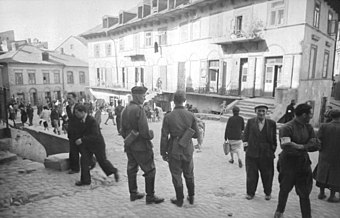Lublin Ghetto
| Lublin Ghetto | |
|---|---|

Two German soldiers in the Lublin Ghetto, May 1941
|
|
| Also known as | German: Ghetto Lublin or Lublin Reservat |
| Location | Lublin, German-occupied Poland |
| Incident type | Imprisonment, forced labor, starvation, exile |
| Organizations | Nazi SS |
| Camp | deportations to Belzec extermination camp and Majdanek |
| Victims | 34,000 Polish Jews |
The Lublin Ghetto was a World War II ghetto created by Nazi Germany in the city of Lublin on the territory of General Government in occupied Poland. The ghetto inmates were mostly Polish Jews, although a number of Roma were also brought in. Set up in March 1941, the Lublin Ghetto was one of the first Nazi-era ghettos slated for liquidation during the most deadly phase of the Holocaust in occupied Poland. Between mid-March and mid-April 1942 over 30,000 Jews were delivered to their deaths in cattle trucks at the Bełżec extermination camp and additional 4,000 at Majdanek.
Already in 1940, before the actual ghetto was pronounced, the SS and Police Leader Odilo Globocnik (the SS district-commander who also run the Jewish reservation), began to relocate the Lublin Jews further away from his staff headquarters at Spokojna Street, and into a new city zone set up for this purpose. Meanwhile, the first 10,000 Jews had been expelled from Lublin to the rural surroundings of the city beginning in early March.
The Ghetto, referred to as the Jewish quarter (or Wohngebiet der Juden), was formally opened a year later on 24 March 1941. The expulsion and ghettoization of the Jews was decided when the arriving Wehrmacht troops secretly preparing for the attack on the Soviet positions in eastern Poland, needed housing close to the Nazi-Soviet demarcation line. The Ghetto, the only one so far in the Lublin district of Generalgouvernement in 1941, was located around the area of Podzamcze, from the Grodzka Gate (renamed "Jewish Gate" to mark the boundary between the Jewish and non-Jewish sections of the city) than along Lubartowska and Unicka streets, to the end of the Franciszkańska Street. Selected members of the prewar political parties such as the Jewish Bund in Poland were imprisoned in the Lublin Castle and continued to carry out their underground activities from there. Widely feared collaborator was Szama (Shlomo) Grajer, owner of a Jewish restaurant with a brothel on Kowalska Street. Grajer was a Gestapo informer. Dressed like a German official, Grajer summoned to his restaurant a number of wealthy Jews and extracted a ransom of 20,000 zloty from every one of them. He also used to hunt for good looking girls starving in the Ghetto for his Nazi brothel, therefore the tight-knit families made sure to hide them from him. Grajer had cornered the beautiful daughter of Judenrat president Marek Alten, and married her. They were shot dead together, during the final liquidation of Majdan.
...
Wikipedia
